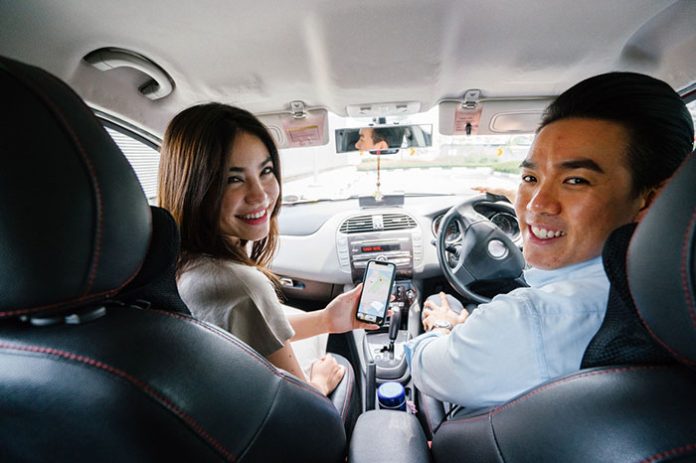Knowing how to drive a car is an indispensable talent, one that everyone should learn. Even if you do not own a car or never had to drive yourself anywhere, it’s still a skill worth acquiring and can prove useful, especially in emergencies.
Like most other life skills, the best way to learn driving in 2024 is by practicing alongside an experienced driver. However, if that isn’t an option for you, this guide is the next best opportunity. Not only is it suitable for you if you’re learning to drive, but is also perfect if you are trying to teach someone how to drive a car.
By the time you’re done reading this guide regarding how to drive a car, you should be knowing the basics of driving a car. We will talk about the various controls and their purpose, the two main types of car transmissions, and their differences. You’ll also learn how to drive a car with both manual and automatic transmissions. Furthermore, we have provided driving tips for beginners so they feel relaxed and safe behind the wheels.
First things first, the basics:
Basics Of Driving A Car:
1. Know the controls:
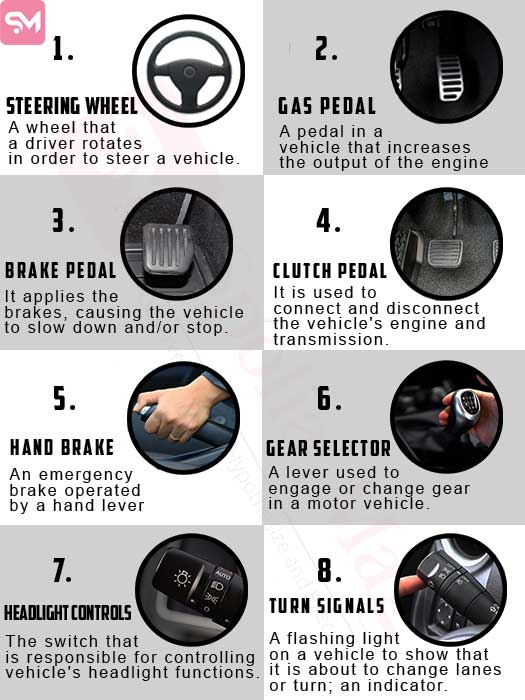
Every car comes with different controls that help you control and operate it. The main ones are:
Accelerator:
The accelerator is in the foot area of the driver’s seat. There is usually more than one pedal and the accelerator is the rightmost pedal. It controls the amount of gas that goes into your engine. It is also known as the throttle or gas pedal.
Brake pedal:
The brake pedal is on the left side of the accelerator and its purpose is to draw the car to a stop or to slow it down whenever you press the pedal.
The steering wheel:
It is a large, circular (mostly), wheel that sits at the center of the console on the driver’s side. It helps you steer the car and avoid obstacles along the way.
Turn signals:
On the left side of your steering wheel is the turn signal lever. It controls the blinkers on your car that alert drivers behind you of your intention to make a turn.
Headlight control:
The headlight control will either be in the form of a lever on the steering column or as a control on the dashboard. Other than controlling the headlights, this control often also manages the fog lights on your car.
Gear selector:
The gear stick is placed either in between the passenger and driver seat or mounted next to the steering wheel. Gear shifts serve different purposes based on the type of transmission your car has. We’ll discuss these later on.
Handbrake:
The handbrake is usually right next to the driver’s seat, which we use to prevent the car from rolling away when parked on slopes or uneven terrain.
2. Get Comfy:
Once you’re familiar with the controls of the car, it’s time to get comfortable with being in the driver’s seat. There are levers located on the side and under the seat, which will let you adjust the seat according to your height and comfort. You should also alter the rearview and door mirror positions to have a good view of the area around your car. According to your height and ease, modify the position of the rearview and side-view mirrors. These mirrors make it easier for you to see the area surrounding your vehicle, so make sure you know how to use them before you drive a car.
3. Wait For The Right Circumstances:
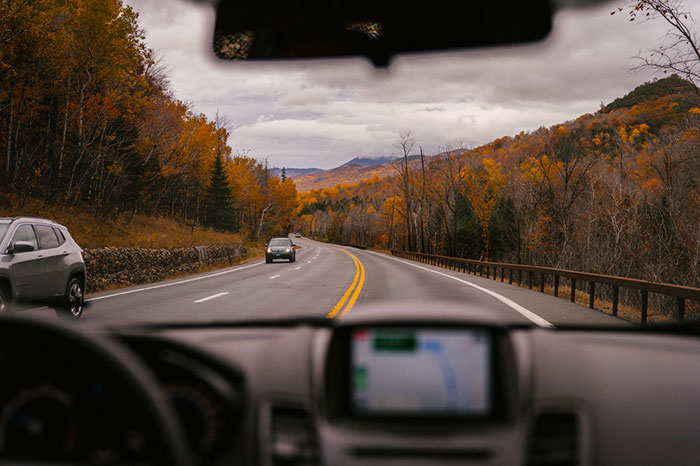
As a learner, you should always drive in clear weather, during the daytime, so you do not have to struggle with visibility. This way, you can concentrate on the basics of driving without having to try and pull off difficult maneuvers.
4. Do Not Get Nervous:

It’s only natural to feel a little anxious when trying out something new but you have nothing to worry about. Driving a car isn’t as tough as you might think. All you need to do is get the basics right and then practice. Put in a lot of practice because that’s the only real way to get the hang of driving. Moreover, being nervous will only make you more distracted, thus less efficient as a driver. You could request an experienced driver to accompany you so that they can point out the little and big mistakes you make while driving. It might be compulsory in certain places, so make sure you’re aware of the law in your state.
5. Driving in the Familiar and Safe Territory:
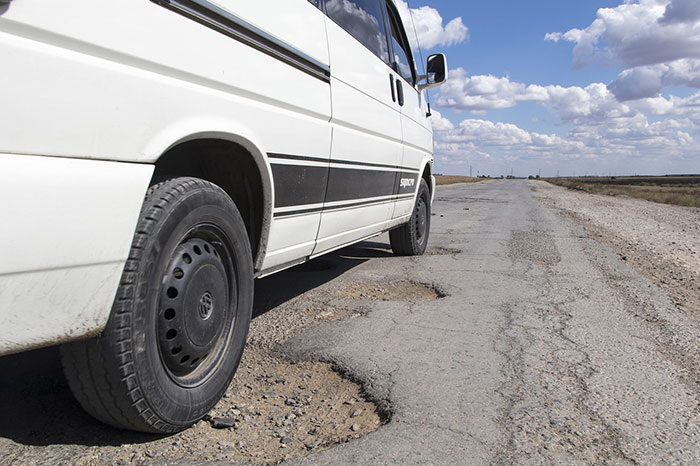
Driving a car in familiar territory is much easier than steering in a completely new area that you’ve never visited. Knowing the vicinity already will mean that you will not have to keep looking for directions, as it can be distracting. You will also already know any obstructions on the road and can avoid potholes or other obstacles effortlessly. Furthermore, while learning how to drive a car you should avoid busy roads or intersections and instead stay in less populated areas. Keeping in account all the aspects, you should choose the best possible road for maximum efficiency of learning. You should venture to the highways and busy areas only when you’re more confident as a driver.
What Car Should You Drive?
Cars come in different body shapes, powerplants, and customizable features. They’re also built on a variety of platforms. All these options like luxury cars, mom cars, sports cars or family cars make buying a car very complicated. While the rest of the options can be narrowed down by preference, the transmission you choose depends on more than just your convenience. There are two main types of transmissions (Automatic and Manual) and each suits different types of drivers based on their needs and expertise.
We will discuss the working of both automatic and manual cars in detail later on in the guide, but here are the main differences between the two types of transmissions.
How to Drive a Car | Automatic vs. Manual Transmission
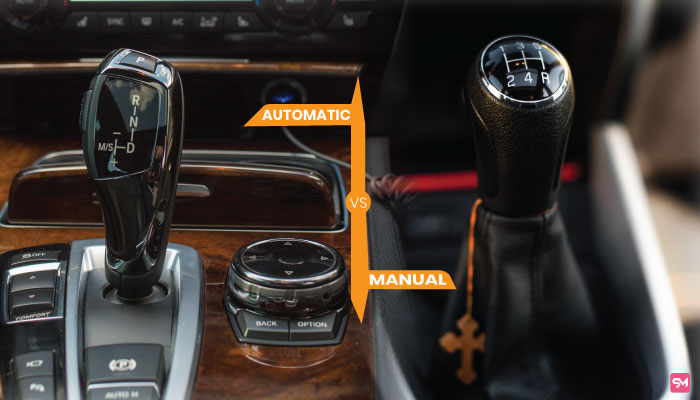
| Automatic Transmission | Manual Transmission |
|---|---|
| Requires little input from the driver | Needs extensive input |
| Easier to drive | Requires practice |
| Good for beginners | Preferred by experienced and performance drivers who like control |
| Expensive | Cheaper option |
| High maintenance costs | Less expensive to service |
| Comparatively less fuel-efficient than manual | Fuel efficient |
How To Drive An Automatic Car:
Vehicles featuring automatic transmission have slowly taken over as the more popular choice for drivers across the globe. Motorists are now gravitating toward automatic cars because of the higher convenience that this type of vehicle offers them. This preference change has been catalyzed by the massive development that automatic cars have undergone. This evolution has helped debunk the long-held belief that vehicles with automatic transmission are inefficient with fuel.
While the main working principle of all automatic gearboxes is the same, we can classify them into six main categories. Knowing these main types will make it easier to understand how to drive a car with a certain automatic transmission system:
1. Traditional Automatic Gearboxes:
This type of transmission uses a torque converter to change gears as a replacement for the clutch in manual transmission cars.
2. Automated-Manual Transmission:
Also known as semi-automatic transmission, this type of automatic gearbox is more similar to manual transmission vehicles. However, instead of using a pedal to select gears, it uses a computer to imitate manual gear changes.
3. Continuously Variable Transmission (CVT):
CVT is popular in hybrid cars due to its greater efficiency and pleasant driving. The system makes use of belts and pulleys instead of steel cogs, which allows for smoother gear shifting.
4. Dual-Clutch Transmission (DCT):
Much like the Automated-Manual transmission system, DCT is also a combination of manual and automatic transmission but unlike the prior, this does not have a torque converter. Instead, it makes use of two separate shafts, one for odd-numbered and the other for even-numbered gears. Both shafts have their own separate clutches.
5. Direct Shift Gearbox (DSG):
A Direct Shift Gearbox also uses two clutches that engage alternatively while changing gears. It results in a smoother acceleration due to faster gear shifts.
6. Tiptronic Transmission:
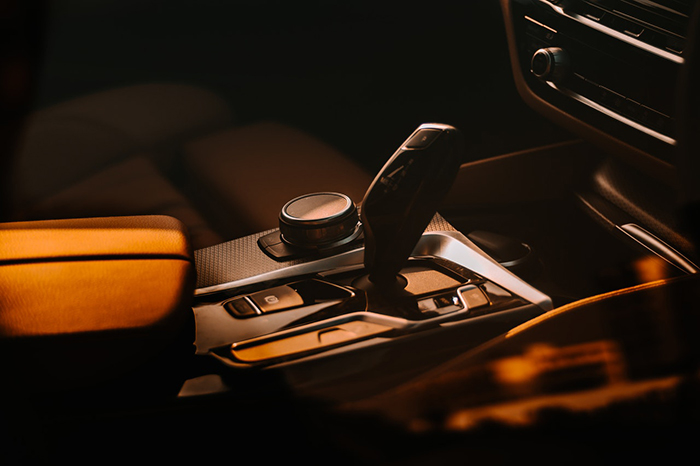
This transmission system works best in performance and sport-oriented vehicles. It is very similar to manual gearboxes but uses a torque converter instead of a clutch. Gear transmission is automatic but the driver can choose to override that system and select gears manually.
Now, are you ready to get to the exciting part, driving a car with automatic transmission?
Here are ten easy steps you should follow:
- Make sure the gear is at the ‘P’ (park level). This level locks the transmission and we use it when there is a need to park the vehicle.
- Check if the handbrake is applied and undo it.
- Place your right foot on the brake pedal (the pedal on the left) and press it down.
- Next, turn the ignition on with the key or button.
- Move the gear shifter to D (drive) if you’re intending on moving forward or R (reverse) if you’re moving backward.
- Slowly release the brake pedal; this should cause your car to move slowly.
- Use the accelerator pedal (right pedal) to speed up the car and the brake pedal to slow down.
- Press pedals with your right foot and keep your left foot rested.
- Use the rearview and side-view mirrors before making turns and cut. Do not forget to use the turn signals and headlights appropriately.
- Once you’ve got the car to where you wanted and parked it away from the road, move the gear to the P position and apply the handbrake so that your car does not roll away. If you’re only parking for a short period, like at a signal, use the ‘N’ gear position along with the handbrake. This puts the vehicle in Neutral gear and is similar to knocking a manual car out of gear.
How To Drive A Manual Car:
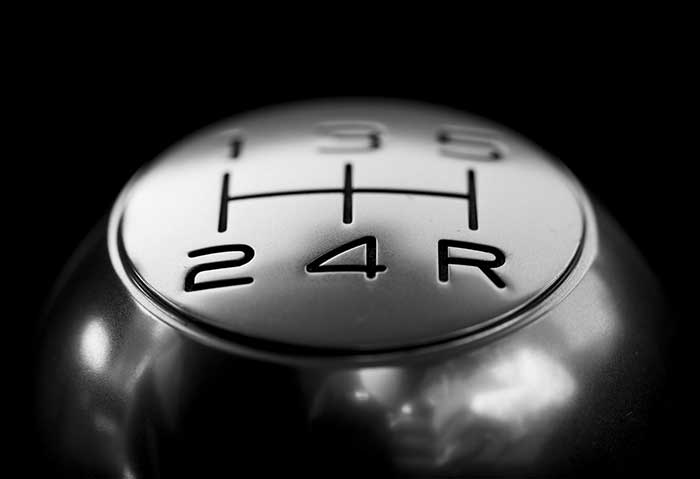
Driving a car with manual transmission is slightly more complicated and therefore less popular. Manual cars do have an accelerator pedal and a brake pedal that function very similar to vehicles with automatic transmissions, but they also come with an extra pedal: the clutch.
Learning the clutch operation is what makes this type of transmission difficult to drive for beginners. Simply put, the clutch is a mechanical device that regulates the transfer of power from the engine to the wheels of the vehicle. When you press it down, you disconnect the wheels from the engine (Confused? You’ll get it, don’t worry!).
Here is how to drive a car with manual transmission:
- Move the gear lever into the center of the shift boot so your car is in neutral gear. To verify that your car is in the neutral gear, wiggle the lever (horizontally at 180 degrees) to ensure that it moves freely.
- Place your foot on the clutch pedal (leftmost pedal) and press it fully.
- Locate the ignition and turn it halfway by either pressing the button or turning the key (depending on the type of ignition your car has). It should allow your vehicle to gather all the necessary readings.
- With your foot still on the clutch and the car still in neutral gear, turn the ignition on fully, and start the vehicle up.
- Disengage the handbrake if needed. If you’re on a steep surface, press down the brake pedal (the center pedal) before releasing the handbrake so that your car does not roll away.
- While pressing the clutch down entirely, move the stick shift into the first gear (the number 1 position in the shift boot). Follow the stick shift pattern displayed on top of the gear lever.
- Slowly release the clutch pedal and at the same time gently press down the accelerator pedal. Do this process extremely sluggishly so that your engine does not stall, although it is perfectly normal even if it does.
- Once you’re through with this process, your vehicle should start to vibrate as the clutch plates begin to come together.
- Increase the pressure on the accelerator and completely release the clutch and the vehicle should start moving forward.
- As the car rev counter reading goes up to 2,000 rpm, shift into the next gear by releasing the accelerator and pressing down the clutch, and then releasing it in the same way as moving into the first gear.
When should you use which gear?
You should use the first and second gears while driving the car below the speed of 20mph. The third and fourth gears offer faster acceleration and more power. We use fifth and sixth gears (if fitted) when cruising to get better fuel efficiency. Some of the recent models will tell you when to change the gear but after some experience, you will be able to determine this yourself. If your engine sounds too loud, shift up the gear but if it seems to be struggling, change the gear down.
How to Drive Tips for Beginners:
If you’re learning how to drive a car on your own, follow these 10 tips and tricks for a more enriching experience.
1. Wear a seatbelt:

There’s a very good reason that the law mandates wearing a seat belt while driving a vehicle. A seatbelt will keep you strapped to your seat in the event of a car crash, thereby minimizing injuries.
2. Acquaint yourself with your car:
Before you start driving a car, you need to be comfortable behind its wheel. Familiarize yourself with the interior and exterior of your vehicle. Learn where all the controls and gears are. Understand the working of each button and the best way to access them. Familiarity, before you start to drive a car, will mean you will not need to keep glancing down or fumbling around for the various controls.
3. Be comfortable:
If you drive a vehicle while seated uncomfortably, you will soon feel a strain on your back or shoulders and will not be able to drive for too long. The adjustment knobs on the side of your seat give you control over both the angle and the seat reach. Your seat should be in a position where all the controls are easily accessible to you and you have a good view of the road ahead.
4. Figure out the best input level:
Many of the car’s components depend greatly on your input. You need to figure out how much gas you should give when speeding up and how hard to press the brakes to slow down. You should also comprehend how much the steering wheel needs to be turned to attain the right level of tilt on wheels. Always start with the lowest level of input and then build up your way to higher input levels.
5. Do not tailgate:
Try to maintain a safe distance from the car in front of you at all times. If you get too close to the vehicle ahead and it encounters a problem, you could end up ramming into it. Not only does the safe distance give you ample time to react to erratic moves by the driver ahead, but it also provides you time to adjust the amount of input you are giving to your vehicle. Overall, this small tip can save both your vehicle and the one ahead from damage. However, if you ever happen to hit the next one out of hard luck, be wise to contact some well-known car accident law firm to guide you handle the upcoming proceedings legally.
6. Learn the proper use of horns and indicators:
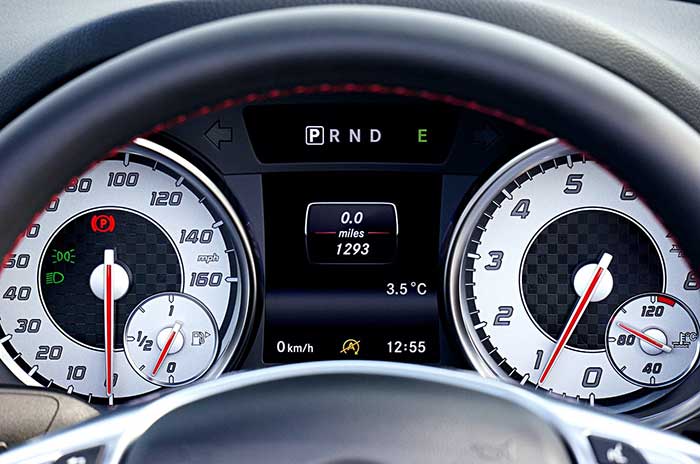
Your car indicators and the horn are two main sources of communication with others on the road. Therefore, you must understand how to use them both before you drive a car. Always ensure that the appropriate turn signals are active while turning or changing lanes. Use the double turn indicator when you think your car is facing an issue to be aware of the vehicles behind you. Alert drivers ahead of your presence with your car horn. Avoid honking at vehicles unnecessarily, especially at signals or in heavy traffic – this serves no real purpose.
7. Install a dashcam:
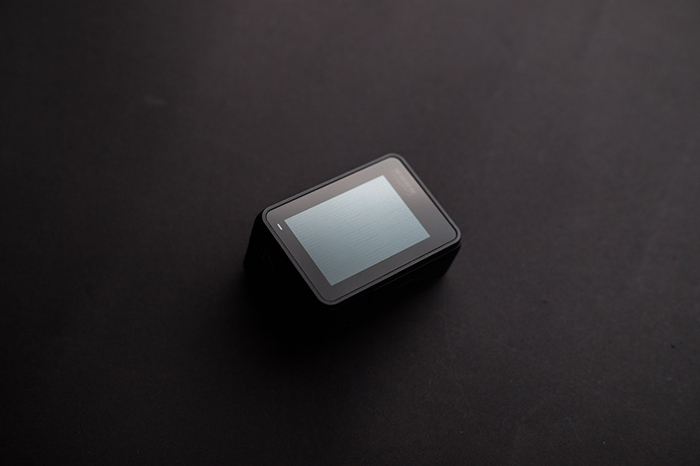
Some modern cars come with a dashcam installed, but even if yours does not, they’re easy and feasible to install. Your dashcam will record everything that you encounter on the road, so if you get into an accident, you’ll have proof of your innocence.
8. Keep up with car maintenance

service your car regularly to avoid breaking down in the middle of the road. Also, try to be present at car checkups and understand what components need immediate repairs and replacement. It is always good to understand the function of different parts in your vehicle, such as the head gasket.
9. Know where the wheels are:
To avoid potholes and other obstacles on the road, it’s vital to be able to locate the position of your wheels. Practice by putting a plastic bottle on the road and driving over it.
10. Prepare for the turns ahead:
Observe the taller vehicles ahead of you to see if the road turns or curves up. It will help you prepare to steer your car ahead of time and you will not panic at the last moment.
11. Follow the Traffic Signals
Always look out for traffic signals. They control traffic flow, and any discrepancies with the flow could cost you a great deal. Moreover, familiarize yourself with complex signs such as turning arrows. It would be best to have a good understanding of pedestrian signals and signs. The majority of accidents occur due to the negligence of the traffic signals, so it is in your best interest to follow them.
12. Do not Speed
We recommend against speeding over the specified limit because you tend to lose control while driving too fast. Moreover, breaking the speed limit increases the chances of more severe injuries in car accidents.
If you wish to stop at a particular location or spot something wrong ahead, you would need a greater distance to come to a halt. Speeding can also cost you monetary terms; you may get a speeding ticket and use more gas consumption.
Conclusion:
Vehicle Driving is an essential survival skill, one that can prove very useful in emergencies. Learning how to drive a car seems like a daunting task, especially right at the start but once you start it, you’ll see how easy it eventually becomes. All you need to do is know the basics of driving a car and the laws in your area. It would be a wise decision to get a learner’s permit first. You might also be required to display an “L” sign on your vehicle, so surrounding drivers know you’re a learner. Once you pass the driving test, you should still practice caution and abide by all the traffic rules to stay safe on the road.
Frequently Asked Questions by People Learning How to Drive a Car:
Initially, every new task seems a little difficult and driving is no different. However, once you get more familiar with it, driving can be as easy as walking or running.
There are many ways to improve your driving skills but the most sure-fire way is practice, practice, and practice.
There isn’t a universal timeline for learning how to drive. It varies from person to person and can be any amount of time from a couple of days to several months. Regardless of how long it takes, just be patient, keep practicing, and do not hesitate to ask for help when needed.
Before you get behind the wheel, comprehend all the traffic laws of the area you’re driving in. Get to know where the roads are two-way and what stops are compulsory. Also, find out if you’re required to have an experienced driver with you while carrying a learner’s permit. In most cases, it is much better that your parent accompany you along the road as parents are known to teach children to drive in a much pragmatic manner.
The car you choose to drive is a very personalized decision and nearly all types of cars are very similar. The only way to know what type of car suits your comfort level is by trying them out. Therefore, there isn’t a definite answer to this question.
Passing a driving test for an automatic car license is much easier than passing a test for a manual. Most people, therefore, opt for the former. The downside to this is that with an automatic car driving license, you can’t drive a car with manual transmission. However, if you have a license for manual cars and know how to drive a car with an automatic system, you do not need a separate license.
Therefore, the decision about what type of license you should get depends on what type of car you own and whether or not you will ever need to drive a manual car.
We understand some matters require an urgent response, but we do not recommend texting while driving. Texting while driving is illegal throughout the world. It is most likely that you could break other traffic laws as well since texting diverts your attention.
Besides, getting a ticket for ‘texting and driving’ can adversely affect your insurance rates. Worst of all – you could get into an accident and not only damage your vehicle, but also others’ property. Besides, all the concerned may also receive serious injuries such as car accident back pain, bone fracture, etc. Spare some moments, park to the side of the road, reply to your messages or calls and then carry on.
Headphone usage while driving can either be legal or illegal depending on where you live, but it is risky nonetheless. We suggest driving without one because it diverts your attention and requires you to multitask. With the distraction, you could forget about crucial measures while driving.
Headphones cut you off from your surroundings, as you cannot hear what’s going on around you. You lose situational awareness, which is risky too.
If you hear sirens nearby, always consult your rear mirror to see if a police officer is trying to pull you over. When you notice a police officer signaling you to pull over, do it as soon as possible. Roll down the window and wait until the officer asks for your registration and license document.
Answer every question sincerely and maintain a polite tone. Arguing would only make the case worse. If the officer issues you a ticket, and you believe it is unfair, you have the right to appeal.


